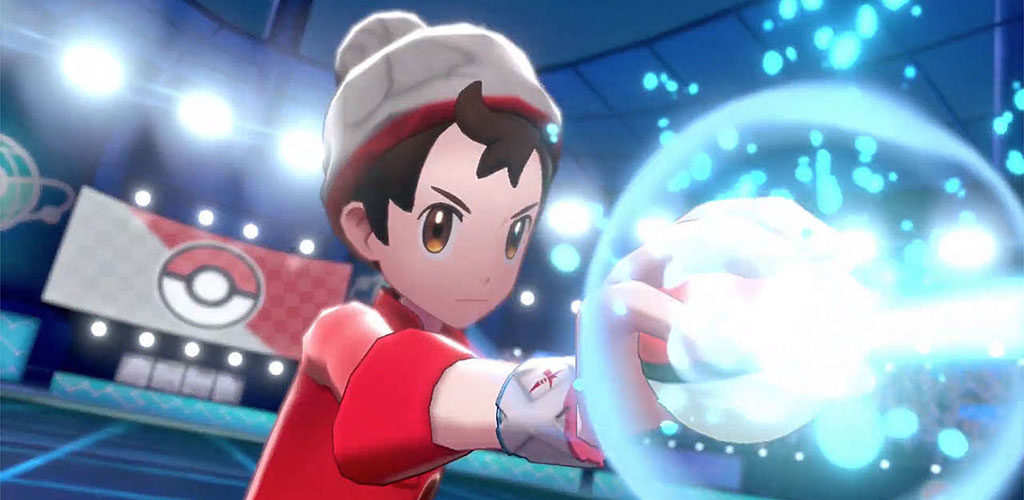Review: Pokémon Sword & Shield
Pokémon Sword & Shield represent the start of the eighth “generation” of Pokémon, and the first all-new traditional Pokémon RPG experience for a home console. Games that move from portable consoles to the big screen can often experience growing-pains, and Pokémon is no exception – Sword & Shield can feel regressive in some areas. That’s not to say that they’re not good, though – there’s yet to be a truly bad Pokémon RPG, and both fans and newcomers will find plenty to like about this latest release.
The set-up is the same as always – you’re a young kid who leaves their home town hoping to become the region’s best Pokémon trainer. The game’s new setting, Galar, is based on Britain, and it’s pretty gorgeous – it’s the first game in the series to feature horizons you can lovingly stare into. You need to travel to the eight gyms scattered across the region, catching and training Pokémon (about 80 of them new to this generation) until you’re eventually ready to face the Galar champion. If you’ve played a Pokémon game before, don’t expect any major deviations or innovative storytelling, or anything as wild as Pokémon Sun & Moon’s journeys into other dimensions. This is a more traditional experience.
Some elements that the series is known for have been pared right down. There are fewer items to unlock, and unlike the Switch remakes of Red & Blue you can’t release your Pokémon from their Poké Balls and have them follow you. Don’t expect any real degree of exploration or puzzle solving during your journey either, outside of the mild challenges posed by some gyms before the final battle (and even these are largely abandoned later). The few cave environments you explore are kept short, and for most of the game you’re travelling in straight line between each new town.
Cutting down on these elements doesn’t just make the adventure a bit less exciting, it makes the whole experience feel less altruistic as well. In past games, you weren’t just trying to become the champion – you were foiling evil organisations, fixing broken elements of the world, doing good along the way. While there are still some traces of that in Sword & Shield, they’re relegated until right near the end of the game, so there’s less of a clear sense of purpose to the first 20-odd hours. That’s not to say that the adventure isn’t plenty of fun, though—as always, it’s hard not to get attached to the creatures that are fighting for you, and the fun, well-animated designs make it easy to love your team. It’s also extremely easy, though – I finished the game without ever being beaten.
Where Sword & Shield excel is in the actual process of catching and training your Pokémon. The big new addition this year is the Wild Area, a huge open space that’s full of wild monsters to catch. Early on, many of the monsters you encounter here are over-levelled and cannot be caught; it’s satisfying returning later with all your badges and finding that now nothing is off limits. Better yet, if your Switch is connected to the Internet you can see other players in the Wild Area too, and even team up with other players for a new type of battle called a ‘Dynamax Raid’. In these battles, the Pokémon you’re battling against are transformed into giants, making them extra hard to take down. You have this power too, in certain instances throughout the game, and it’s pretty exhilarating watching your favourite creature grow huge before attacking with extra-powerful moves.
If you’re a returning expert, Sword & Shield has some interesting tweaks for higher level play, and are designed to make it a bit easier to assemble and train a really powerful team. This is a good thing, since Pokémon is such a social activity, and trading and battling with friends is still a huge part of the series’ success. I found myself using the online ‘Surprise Trade’ option often, which lets you send a Pokémon of your choice to another player somewhere else in the world and receive whatever they sent you back. Often, I’d receive common Pokémon, but plenty of users sent me critters that are very hard to find and catch, much to my delight. Surprise Trade speaks to the generous spirits of other players, and makes you feel connected to a wider community.
In many ways these games feel transitional, like slightly lesser entries in the Pokémon canon that will serve as the basis for a much stronger follow-up. But Pokémon is a comfort-food series for a lot of people, and like a bowl of hot chips, it’s easy to keep picking away at it even if you’ve had better.
Pokémon Sword & Shield are out now on Nintendo Switch.
James O’Connor is a journalist and critic.













